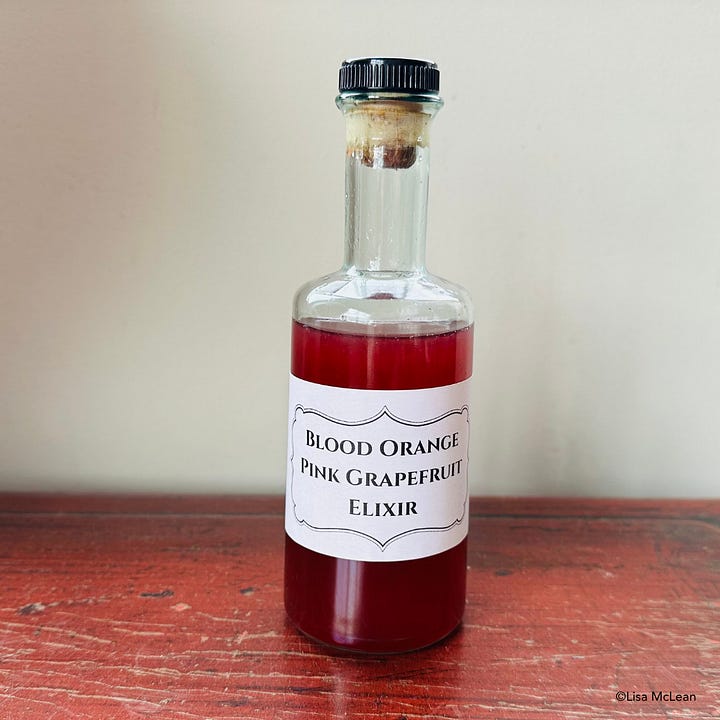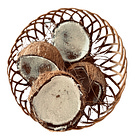More Leftover Alchemy, coconut vinegar, kimchi, rosti, arancini, sweet elixirs
Transforming leftovers into vinegars, sauces, pies, jams and kimchi—how a week’s worth of scraps became meals, preserves, and new delights.
This is Spice Chronicles, a journal of cooking, memory, and the fragrant trail spices leave across time and culture. I’m Lisa McLean, clinical naturopath and lifelong student of the cooking, writing from a place where the monsoon meets the market basket. Recipes, yes, but also stories, traditions, and the alchemy of a well-cooked meal.
If these posts speak to you, consider subscribing or upgrading to a paid subscription to help support the slow work of writing, testing, and sharing these dishes.
We cook, we share, we feast, and then comes the quiet after. The last guest leaves, the kitchen exhales, and I’m left with a table full of leftovers and possibilities. This is where the alchemy begins.
There’s a particular satisfaction in cooking something wonderful from what others might discard. A green salad reborn as a savoury pie, a sorbet’s spent peel transformed into jam, the ends and remnants finding a second, often more interesting, life.
Here’s what emerged from my kitchen in the last couple of weeks.
Coconut Vinegar from Class to Glass
After my recent Sri Lankan cooking class, I found myself with a jug of leftover coconut water. Too good to waste, so I thought to turn it into coconut vinegar, as I’ve had trouble sourcing it locally recently.
I strained the coconut water, then warmed it through gently with sugar, stirring until dissolved, then poured it into a glass vessel. I covered the top with kitchen muslin and secured it with a band. After a few days out of the sunlight, it smelled faintly boozy, perfect. I added a spoonful of vinegar mother and let it sit for a few weeks. The result is a delicate, slightly floral coconut vinegar with a rounded acidity and a hint of tropical sweetness. A bottle of transformation, straight from the scraps of class, although I would never discard fresh coconut milk, I’d freeze it in large silicone ice cubes at the very least if I had nothing else to use it for. But now that I’ve mastered coconut vinegar, I know what I’ll be doing with excess coconut water in future.
Green with Envy Pie
The Green with Envy salad had a short but celebrated life, broad beans, green chickpeas, peas, celery, and thinly sliced potatoes dressed in herb oil. But a few spoons remained the next morning.
So I layered the potato slices into a small loaf tin, tumbled the peas and beans on top, whisked in a few eggs, scattered in some ribbons of salami, and baked the lot until golden and puffed. A grating of parmesan sealed the deal. Breakfast, lunch, or picnic fare, it was exceptionally tasty.
Pork Terrine Gnocchi Sauce
There was a pork terrine I made for a ploughman’s platter which I will write about soon, but the terrine was abundant. Too much for sandwiches alone. So I put on a batch of Marcella Hazan’s Tomato Sauce III, the one with onion and butter that slowly coaxes tomatoes into their fullest expression, then added the pork, bacon and prunes from the terrine and let them get to know Marcella’s sauce. After an hour of gentle bubbling, the pork melted into the sauce, giving it a richness that clung beautifully to potato gnocchi.



Cabbage and Kidney Bean Risotto → Arancini → Rosti
Marcella Hazan’s Risotto coi fagioli rossi (red kidney beans and cabbage) is humble and satisfying. But I rarely make just enough risotto for one meal. The next day, I rolled the leftovers into small arancini, tucking a parcel of chevre in the center and fried them to golden. A crunchy exterior, a creamy, savoury centre melding with the rice. A perfect snack on the go, or with Marcella’s simple tomato, cucumber, onion and basil salad, my new favourite salad on rotation in my kitchen.
With the risotto left after making arancini, I pressed spoonfuls into a sandwich press, after removing the beans, and toasted them for ten minutes until they formed crisp little rosti cakes. It looked hopeless at first: a pale, sloppy mess. But patience revealed the alchemy. These risotto rosti were exceptional for breakfast, dipped into runny eggs and a spoonful of the tomato butter sauce from earlier.


Three Lives of a Pink Grapefruit
It started with a sorbet, Campari and pink grapefruit, made while my sister was visiting. After juicing the fruit, I couldn’t bear to discard the skins. I sliced them, threw in a few aging sweet sapphire grapes then added castor sugar, and left them in the sun for a few days to produce a thick, sweet elixir perfect for summer spritzes or sharp vinaigrettes.
After draining off the syrup elixir, I blended the softened rinds and black grapes, then simmered the mixture down with water, then again with pomegranate juice. A bit of sugar to balance it, a brisk bubble to set it. The result was a deep, slightly bitter jam that tastes like grown-up marmalade with a backbone. From sorbet to syrup to conserve, every drop found a purpose.




Herb Vinegar from Herb Oil
When I made the Green with Envy salad, I blitzed parsley and garlic chives into a vivid green herb oil. But after straining, I was left with a wet, fragrant pulp, too good for compost just yet.
So I steeped the pulp in rice wine vinegar for awhile. What emerged was a delicately flavoured herb vinegar, still tasting of chlorophyll and spring. Only then did the pulp go to the compost. Extraction, then transformation, then nourishment.
Apple and Grape Chutney
Some apples had lost their crunch. A handful of grapes were halfway to raisins. So I did what I often do: cooked them down with vinegar, onions, mustard seeds, and spice until they turned thick and dark and sweet. A chutney with a mild tartness and just enough heat to keep it interesting. It’s now on heavy rotation, on toast, next to eggs, folded through yoghurt, or beside a hunk of cheese.
Water Kimchi from Leftover Wombok
After a recent Korean supper, I was left with an entire bowl of lightly blanched wombok leaves, prepared to wrap grilled meats and spicy sides into little parcels. I didn’t want to waste them, so I turned to one of my favourite fresh ferments: Nabak Kimchi, or water kimchi, or my version of it at least.
I’ve been making kimchi for years, since moving to the tropics before the culinary trend took off. If I wanted Kimchi, I’d need to make it myself back then. Before I learnt the traditional method of making kimchi, from the wonderfully generous Hyosun Ro at Korean Bapsang, I’d come across another old recipe for kimchi, which I still enjoy at times. It’s more of a fresh or quick kimchi, but it can certainly be left to develop, but can be eaten within a day. Now that’s a good thing. Here’s what I do.
I wash the cabbage and soak them in salted water for a few hours, perhaps even over night. I then cut up lots of garlic and ginger and fresh chillie, and perhaps some daikon radish, and some spring onions, then mix it through the drained cabbage. You then pack it all into a sanitised glass jar, and top up with a mix of dashi stock, with a couple of tablespoons of gochugaru (Korean Chilli powder) a dash of light soy and fish sauce. This time I used a mix of bonito dashi and kombu dashi, which you can buy from Asian grocers.
The result is a crisp, tangy light ferment with clean heat and soft garlic undertones, a welcome addition to rice bowls, grilled fish, or simply eaten cold on it’s own for a mid afternoon snack or with some tuna on a rice cracker. If you don’t have time for a traditional kimchi, then give this one a try, it’s really delicious.
There’s a kind of quiet satisfaction in using things fully, especially when the second life reveals something new. Cooking this way isn’t about frugality, though it can be. It’s about attention, about honouring what remains. About seeing potential in the half-empty jar, the softening fruit, the cooling pan.
I call it leftover alchemy. But really, it’s just cooking with care. This is the second in my Leftover Alchemy series, I’ll return to it from time to time, when I have something special to share. In the meantime, I hope you take some inspiration from this post, and find ways to reinvent dishes or ingredients to squeeze every last drop of flavour and goodness out of what you have.
I’d love you to subscribe to Spice Chronicles and leave a comment or press the little heart, it really does make a difference.
©Lisa McLean 2025











I’m impressed by the use it til the last drop idea! Wonderful!
lovev ow you let the creative juices out giving new life to what's left behind